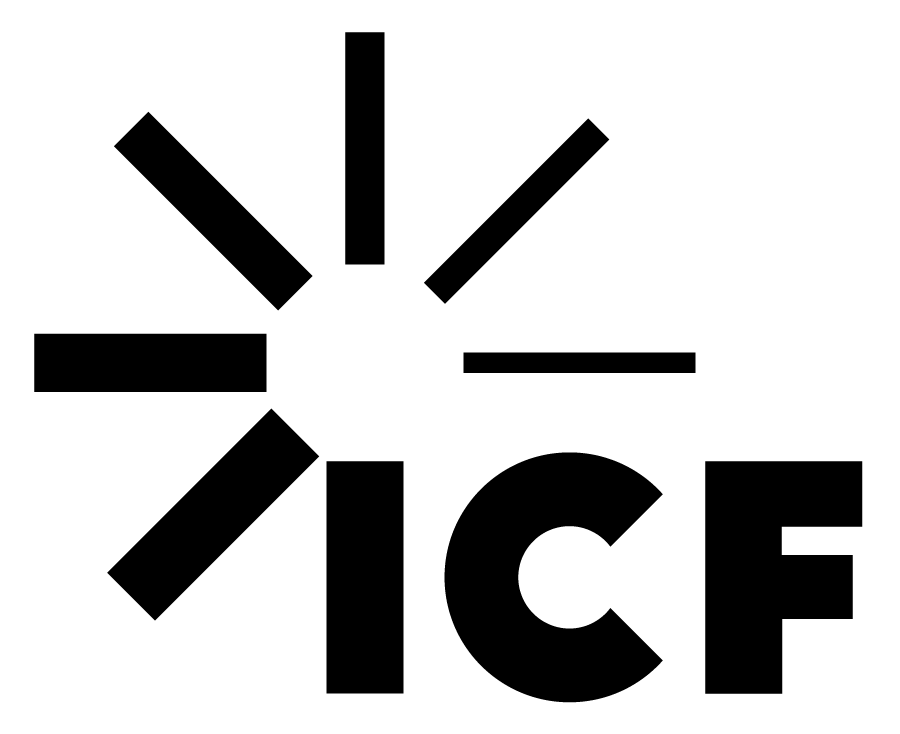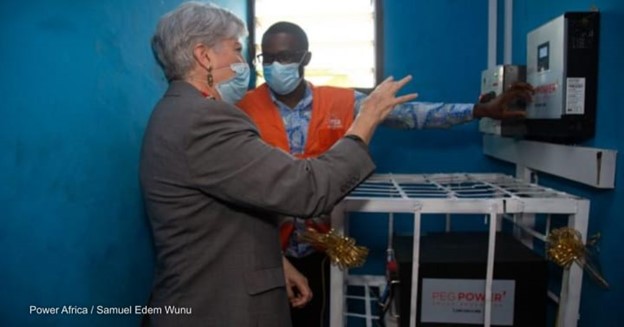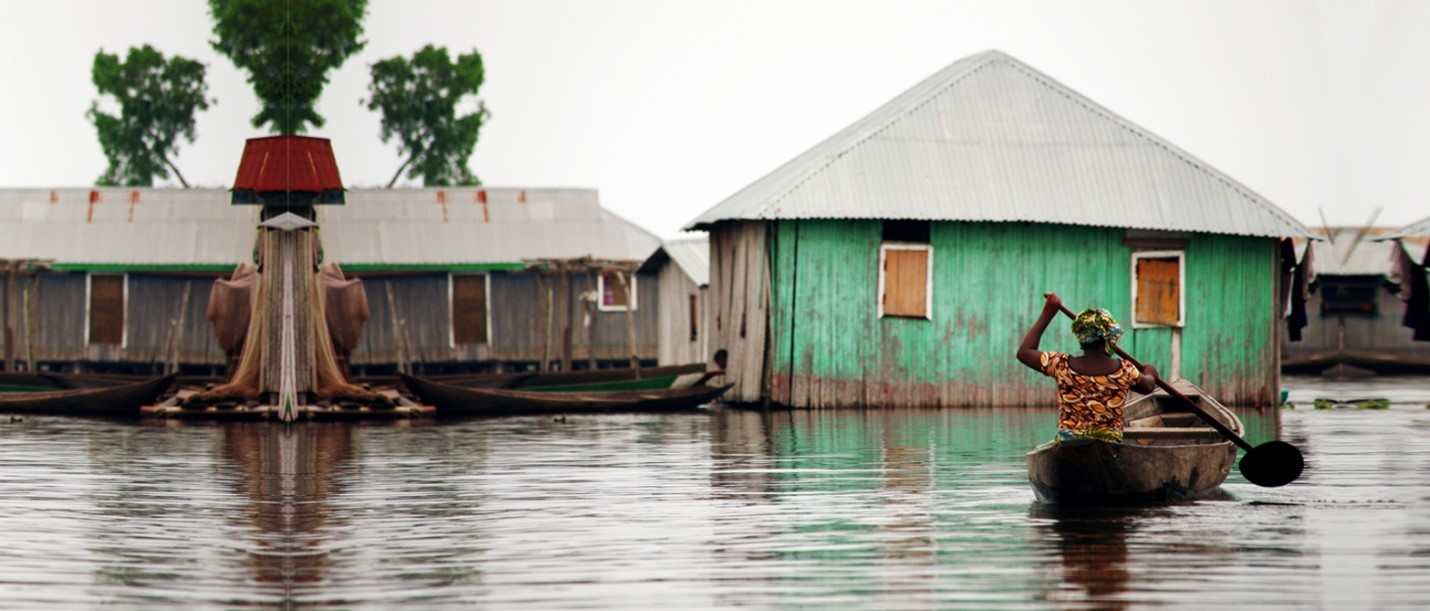

A rural clinic in Ghana that runs on solar power, through a USAID/Power Africa health facility electrification grant. Photo by: Power Africa/Samuel Edem Wunu
Scale these lessons from Ghana to help fight climate change
By Molly Hellmuth , Peter Schultz
It’s no secret that low-income nations pay the highest price for increasingly deadly floods, hurricanes, wildfires, droughts, and blistering heat, yet they are the least equipped to bounce back from extreme weather events that devastate lives and livelihoods. ICF Climate Center experts working in Ghana learned three important lessons in climate resilience that can be applied around the world.
A recent Intergovernmental Panel on Climate Change report that found that “the scientific evidence is unequivocal: climate change is a threat to human well-being and planetary health.” The imminent threat of climate change gives high-income nations a brief and rapidly closing window to help lower-income countries transition to greener economies and adapt to climate change.
The stakes are high. The report, for example, found that people on the African continent could experience a 118-fold increase in exposure to extreme heat — far greater than many high-income nations.
High-income nations have already pledged $100 billion a year to help lower-income countries fight climate change. The question now is, how can these investments achieve the biggest bang for the buck?
We have more than 40 years of experience planning and implementing climate initiatives in more than 100 countries from Morocco to Nepal. We’ve found three strategies that are essential, as illustrated in our work in Ghana.

1. Use state-of-the-art climate modeling
This practice applies highly sophisticated science to project data about climate risks in the future. With climate change increasingly causing extreme weather events worldwide, this protocol for planning is indispensable since it roots action in the best available information, versus mere speculation and opinion.
In Ghana we leveraged state-of-the-art climate modeling, in partnership with the U.S. Agency for International Development, to help the government of Ghana overhaul its energy infrastructure. The modeling projected several high-likelihood phenomena in the offing. By mid-century, Ghana’s average annual temperature is expected to increase by 1.2 to 1.7 degrees Celsius, and sea levels to rise by about 0.4 to 0.7 meters (1.3 to 2.3 feet). In addition to threatening lives and livelihoods, such outcomes will trigger higher storm surges that damage power plants, substations, and transmission lines in the coastal zone.
Only if a country takes into account potential future climate risks using the best available information can it robustly guide decisions about how best to counter the effects of climate change, while taking into account the sometimes sizable uncertainty associated with climate change.
2. Pursue climate equity
The Biden administration has made equity a priority for climate programs. Women, Indigenous people, and coastal and rural populations are among those most vulnerable to climate impacts. Ensuring equity in climate adaptation programs is both humane and effective.
As it happens, those most susceptible to harm are often on the front lines of adapting to climate change. For example, women — who make up approximately 43% of agricultural labor in low-income countries — are instrumental in keeping crops resilient during severe drought.
The good news is that tools are available to promote climate equity — and, as a direct consequence, foster economic growth. In Ghana, roughly 2 million people live in rural or isolated areas, where the national grid is unlikely to reach within the next 10 years. Mini-grids have emerged as an important energy source, acting as distributed networks equipped to meet demand for these vulnerable populations.
These mini-grids can operate independently from the main power grid. As such, they can be constructed quickly as modules, generate power from local resources such as wind and sun, and, importantly, deliver clean energy in areas where the need is greatest.
3. Forge a sustainable local partnership
If you want to be there for the landing, you have to be there at the takeoff. The planning stage behind major projects should involve partnering with the people affected by the project and the local government and local companies.
High-income nations need to be humble in recognizing that solutions that come from outside often fall short of the mark. In every instance we’ve observed, the best long-term development work empowers local leaders. They can ensure that foreign aid goes toward cultivating in-country talent and technology and that solutions build on local knowledge and meet priority needs.
In Ghana we partnered with local energy stakeholders to elicit their knowledge and expertise, understand and prioritize climate risks that are difficult to pinpoint solely through analysis conducted from thousands of miles away, and identify solutions they’re already employing to address risk. This was all to ensure that planned improvements for Ghana’s power sector took root effectively and sustainably.
With support from USAID, we helped the government of Ghana develop a master plan, based on our modeling assumptions about measured risks, that over time would expand energy capacity. This approach would save the government roughly $300 million.
The situation in Ghana is not unique. The urgency for high-income nations to help address increasing climate impacts in lower-income countries — in the name of preserving economic, environmental, and social improvements — grows daily. Prioritizing use of state-of-the-art climate modeling, climate equity, and sustainable local partnerships will go far toward addressing the urgent threats in the IPCC report before the “brief and rapidly closing window” actually closes.